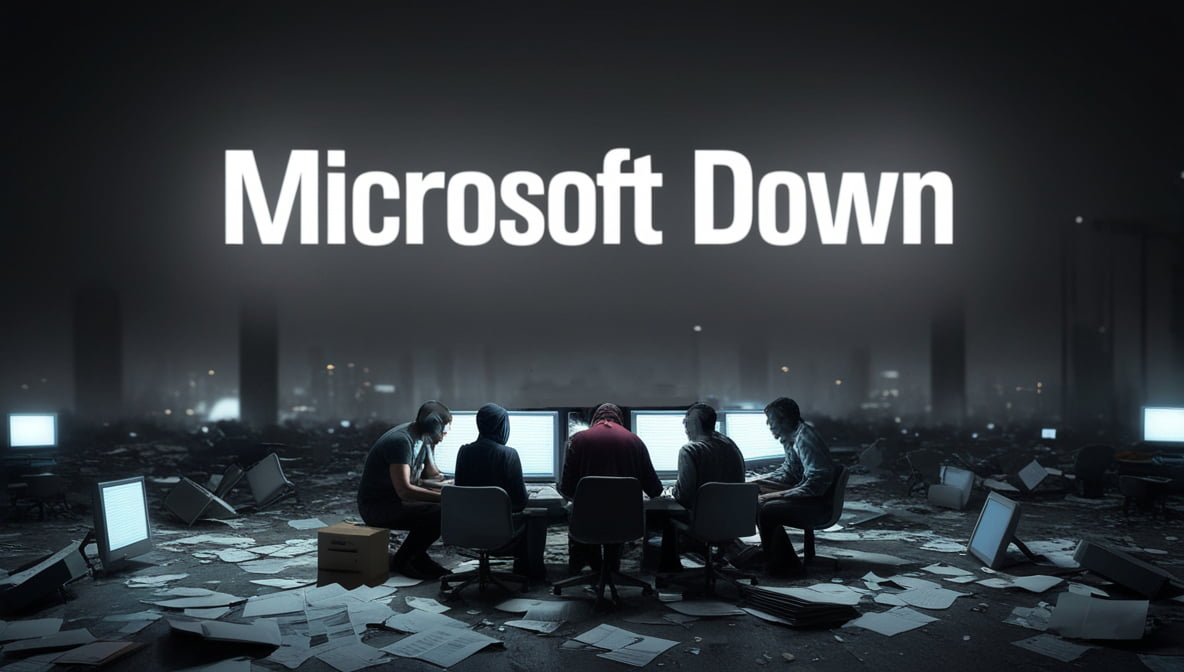Waking up to find not only your Outlook emails inaccessible and Teams meetings in disarray but also your Microsoft Windows operating system failing to function properly. It’s a scenario that could bring modern life to a standstill, affecting businesses, individuals, and even critical infrastructure. Let’s get into the potential consequences and ripple effects of such a massive outage. For many, this scenario isn’t just a hypothetical; it’s a reality that can disrupt daily life and business operations significantly.
What exactly are Microsoft services, and why do they matter?
Before we delve into the chaos that could ensue, let’s get our bearings. Microsoft services encompass a wide range of tools and platforms that billions of people and businesses rely on daily:
- Windows: The operating system that runs on approximately 75% of desktop and laptop computers worldwide
- Office 365 (now Microsoft 365): This includes staples like Word, Excel, PowerPoint, and Outlook
- Microsoft Teams: The go-to communication platform for many organizations
- Azure: Microsoft’s cloud computing service that hosts countless websites and applications
- OneDrive: Cloud storage for personal and business use
- Xbox Live: The online gaming service for Xbox consoles
These services are deeply integrated into the workflow of countless organizations and the daily lives of individuals. From small startups to multinational corporations, from government agencies to educational institutions, Microsoft’s ecosystem is often the backbone of productivity, communication, and basic computer functionality.
The Initial Shock and Panic
Let’s be honest, the first reaction would probably be a mix of shock and panic. For many businesses and individuals, Microsoft services are the backbone of daily operations. Without access to email, documents, cloud services, and even the operating system itself, productivity would come to a grinding halt.
What Would Happen During a Microsoft Outage?
When Microsoft services go down, the immediate concern for users is access. Many people rely on Microsoft 365, which includes popular applications like Word, Excel, and Teams, for their daily tasks. A sudden outage would leave countless individuals and businesses scrambling to find alternative solutions.
How Will it Affect Businesses?
Can businesses function without email, Teams, and Windows?
- Communication Breakdown: Without Outlook and Teams, businesses would struggle to communicate internally and externally. Imagine trying to coordinate a project or respond to urgent client queries without these tools.
- Document Access Issues: With OneDrive, SharePoint, and even local Windows access down, accessing important documents and files would be impossible. Many companies rely on these solutions for their daily operations.
- Project Delays: Ongoing projects would face significant delays. Teams rely on Microsoft Project, Excel, and other tools for planning and execution. Without them, maintaining timelines and milestones becomes a challenge.
Would there be financial implications?
- Revenue Loss: Downtime translates to lost revenue. For every hour that Microsoft services are down, businesses lose money. This can be particularly devastating for small businesses.
- Operational Costs: Companies might need to invest in temporary solutions or alternative services to keep things running. This can incur additional costs that were not budgeted for.
The impact on businesses would be even more severe with Windows affected:
- Complete workflow disruption: Even local files and applications might be inaccessible
- Hardware issues: Printers, scanners, and other peripherals that require Windows drivers could become unusable
- Legacy software problems: Many businesses rely on older, Windows-only software that would be completely inaccessible
- IT support overwhelm: IT departments would be inundated with support requests, potentially without the tools to address them
How Will This Affect Individuals?
Widespread computer inaccessibility: Many users might find their computers unbootable or severely limited in functionality
Could people work from home effectively?
- Remote Work Disruptions: With the rise of remote work, many rely on Microsoft Teams, OneDrive, and Office 365 to stay productive. A service outage would force employees to find alternative ways to communicate and collaborate.
- Increased Stress: The sudden unavailability of familiar tools can cause stress and anxiety. Employees may worry about meeting deadlines and maintaining productivity without their usual resources.
What about students and educators?
- Education Disruptions: Schools and universities that use Microsoft tools for virtual learning would face major disruptions. Students might miss out on important lessons, and educators would struggle to manage classes and assignments.
- Impact on Learning: Access to resources like Microsoft Word and PowerPoint is crucial for completing assignments and projects. An outage could hinder the learning process, causing delays and frustration.
How Will This Affect Critical Systems and Governments?
The impact on critical infrastructure becomes a major concern:
- Government operations: Many government agencies rely heavily on Windows, potentially affecting public services.
- Emergency services: 911 dispatch systems often run on Windows, potentially compromising emergency response.
- Utilities: Power grids and water treatment facilities frequently use Windows-based control systems.
- Transportation: Air traffic control, railway systems, and logistics often depend on Windows-based software.
- Industrial systems: Many industrial control systems run on Windows, potentially affecting manufacturing and utilities.
- Healthcare disruption: Hospital systems often rely on Windows, potentially impacting patient care and record access.
The potential for a Windows outage to affect critical infrastructure underscores the systemic importance of Microsoft’s products and the need for robust contingency plans.
Has Anything Like This Actually Happened Before?
While a full-day outage of all Microsoft services is an extreme scenario, smaller-scale incidents have occurred:
- A recent Microsoft outage on July 19, 2024, caused significant disruptions across various sectors and companies worldwide. The outage had a profound impact on airlines, leading to numerous flight cancellations and delays. It extended to the financial sector, affecting stock trading and banking operations. Retailers in Australia reported payment system failures, leading to long lines and frustrated customers. Sky News in the UK went off air due to the outage, highlighting the impact on media services. Some telecom services experienced disruptions, affecting communication capabilities during the outage. Reports indicated that 911 services in certain areas were also impacted, raising concerns about public safety during the outage. This incident underscores the critical nature of cloud services and the interconnectedness of modern technology.
- In March 2021, Microsoft experienced a significant outage affecting multiple services, including Teams and Azure, lasting several hours
- In September 2020, a widespread outage impacted Office 365, Outlook, and Teams for several hours
These past events, while shorter in duration, give us a glimpse into the potential chaos a full-day outage could cause.
When outages occur, social media often becomes a platform for users to express their frustrations. For instance, during a recent Microsoft outage in July 2024, users reported issues like the infamous “Blue Screen of Death” which left many computers stuck in restart loops. Comments ranged from humorous to exasperated, with users sharing their experiences of lost work and disrupted plans.
How Do Companies Respond to Outages?
When faced with a significant outage, companies like Microsoft typically work quickly to resolve the issues. Here’s how they generally respond:
- Acknowledgment: Microsoft would likely issue a statement acknowledging the problem and updating users on the situation.
- Restoration Efforts: The company would deploy technical teams to investigate the cause and restore services as quickly as possible. For example, during a recent outage, Microsoft reported rerouting traffic to alleviate the impact on users.
- Communication: Regular updates via social media and official channels would keep users informed about progress and expected resolution times.
What Can Users Do During an Outage?
While waiting for services to be restored, users can take certain steps to mitigate the impact:
- Alternative Tools: Explore alternative applications for communication and file storage. For example, Google Drive and Slack can serve as temporary substitutes.
- Offline Work: If possible, switch to offline modes of work. Many Microsoft applications allow for offline editing, which can be synced later.
- Stay Updated: Follow official channels for updates on the situation. This can provide clarity on when services are expected to be restored.
Conclusion
The thought of Microsoft services, including Windows, going down for an entire day is daunting. It would disrupt businesses, individuals, and educational institutions alike. However, it also serves as a wake-up call to the importance of preparedness, redundancy, and flexibility in our increasingly digital world. By planning ahead and having contingency measures in place, we can navigate such challenges more smoothly.
The reality is that technology is deeply integrated into our lives, and outages like these serve as a reminder of our reliance on these systems. As we become increasingly dependent on digital services, understanding the potential impacts of outages helps us prepare for the unexpected.






